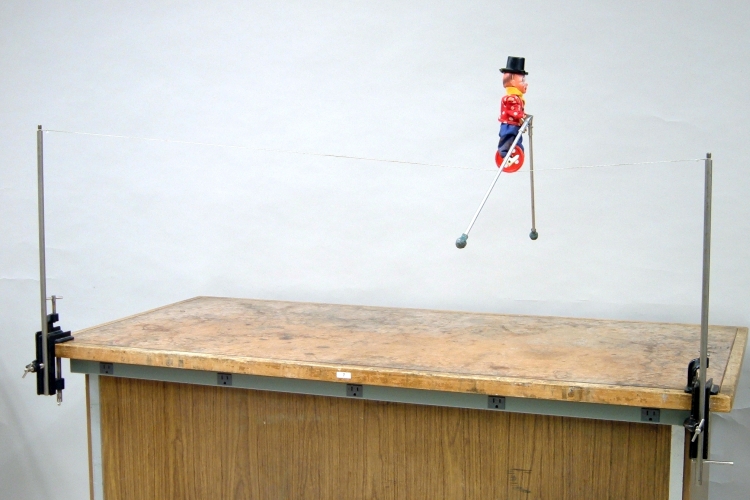
A video of this demonstration (listed as demonstration 24.24) is available at this link.
A toy clown sitting on a unicycle, holds an inverted-V-shaped rod at whose ends are lead masses. These masses are great enough to bring the center of mass of the clown on his unicycle to a point somewhere below the tightrope. If you tilt the clown to either side, this raises the center of mass of the system, and when you release him, he returns to the center. The clown is thus in stable equilibrium, and can ride the tightrope without falling off it.
The center of mass of an object is the weighted mean displacement of all of its mass points from some reference point, usually the origin of the coordinate system in which the object sits. This is the sum of the products of all the mass points with their distances from the origin, divided by the total mass of the object (rcm = Σmiri/M). If we set the center of mass of the object at the origin, we find that this sum equals zero. This tells us that if we exert a force on the object at its center of mass, this results in no torque on the object, but if we apply a force to the object at any other point, as long as the line of force does not go through the center of mass, we exert a torque on the object about its center of mass. If the object is relatively small, and close to the earth, then gravity acts uniformly on the object. That is, if the object is of uniform density, gravity exerts the same downward force on all of its mass points, and the sum of all of these forces is equal to a single downward force, F = Mg, acting at the center of mass of the object.
The masses at the ends of the V-shaped rod that the clown is holding, are great enough to bring the center of mass of the clown-unicycle-rod system to a point somewhere below the tightrope on which it sits. If you displace the clown to either side, the center of mass of the clown-unicycle-rod system moves along an arc of a circle centered about the point of contact of the unicycle wheel and the tightrope. It thus rises as you tilt the clown to either side, and the gravitational potential energy of the system thus increases. To raise the center of mass of the system by pushing the clown to the side, you exert a torque about the point where the wheel sits on the tightrope. Gravity, acting at the center of mass of the system, exerts an opposing torque about the same point, to lower the center of mass to its original position, and thus decrease the gravitational potential energy of the system. The clown is thus in stable equilibrium (see demonstration 32.20 -- Neutral, stable and unstable equilibrium). If he should be displaced to either side, gravity returns him to his original position, and he can ride down the tightrope without fear of falling off it.
References:
1) Resnick, Robert and Halliday, David. Physics, Part One, Third Edition (New York: John Wiley and Sons, 1977), pp. 162-5, 283-5, 291-3.